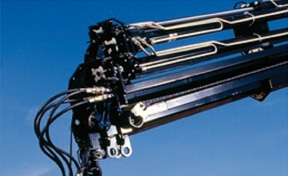 The research team will develop design strategies that incorporate advanced light materials in applications for load handling structures. |
Hiab is a step closer to developing new products that weigh less and use less fuel as it reports on "significant progress" in the research initiative it established with its academic partners in 2013.
The project that was launched last year involves Hiab engineers and partners from the West Pomeranian University of Technology in Szczecin and the Silesian University of Technology, Poland. The EU's Industrial and Academy Partnerships contributed EUR 1.4 million (USD1.9 million) in funding.
Rafal Sornek, vice president of research and development at Hiab, says the collaboration combines resources from industry and academia and is "enlightening".
"The program is already delivering significant advantages, particularly when compared to the more traditional method of outsourcing the 'innovation race' to universities. Networking with external partners and working towards common goals is allowing us to create really valuable ideas and quickly adopt them for development," Sornek explains.
To date, the research with the academic partners has concentrated on load-handling equipment focused specifically on improving operational safety and equipment efficiency.
The research team was also assigned to develop design strategies that incorporate "advanced light materials" in applications for load-handling structures, to reduce weight and fuel consumption.
"From Hiab's perspective, the team of Hiab engineers and our new partners have integrated exceptionally well, and this has resulted in outputs that are far better than expected. For example, the new workflow is allowing a significant reduction in product development timescales and costs.
"We are also realising valuable efficiencies in the areas of prototype testing and advanced simulation. I would go as far as to say that we are introducing a revolution in how we design load-handling equipment for the future," Sornek says.
"There is still a great deal to be done but the results obtained so far are very encouraging to all participants. In 2015, we plan to start training the product line research and development team in new technologies. Following that, the next stage of the research journey, from new technology to new products, will begin," he concludes.
In May, Hiab announced that it was investing EUR2 million (USD2.7 million) in its product development and test centre in Hudiksvall, Sweden
(Forkliftaction.com News #669). The investment will enable the company to develop and test technologies more thoroughly and to launch innovative new technology on the market more quickly.
Hiab celebrates its 70th anniversary this year. The "Hiab method" was born when Eric Sundin, who co-founded Hiab in 1944, found a way to transfer the hydraulic momentum from a truck engine into a lifting motion
(Forkliftaction.com News #668). The Hiab method can be seen today in the eight brands that comprise Hiab's product offering.
Around 2,700 professionals work at Hiab and its load-handling products include Hiab loader cranes, Jonsered recycling and forestry cranes, Loglift forestry cranes, Moffett truck-mounted forklifts and Multilift demountables, as well as Del, Waltco and Zepro tail lifts.
Hiab is part of Cargotec. Cargotec's sales totalled EUR 3.2 billion (USD4.3 billion) in 2013 and it employs approximately 11,000 people.